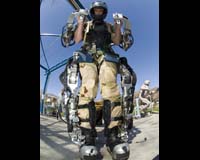| . |  |
. |
Fort Worth TX (SPX) Apr 08, 2010 The first mission systems-equipped Lockheed Martin F-35 Lightning II stealth fighter flew for the first time today, ushering in what will be the most powerful and comprehensive sensor package ever to fly in a fighter. During the flight, F-35 Test Pilot David Nelson climbed to 15,500 feet (4,700 meters), verified engine response at varying throttle settings, performed a series of flight-qualities maneuvers and checked the operation of the aircraft's mission systems. The flight out of Lockheed Martin's Fort Worth plant began at 10:04 a.m. CDT and concluded at 10:59 a.m. "Today's flight initiates a level of avionics capability that no fighter has ever achieved," said Eric Branyan, Lockheed Martin F-35 deputy program manager. "The F-35's next-generation sensor suite enables a new capability for multi role aircraft, collecting vast amounts of data and fusing the information into a single, highly comprehensible display that will enable the pilot to make faster and more effective tactical decisions." The F-35's avionics, or mission systems, also process and apply data from a wide array of off-board sensors based on the land, in the air or at sea, enabling the jet to perform command-and-control functions while providing unprecedented situational awareness to air and surface forces. The F-35's full mission systems suite includes: Northrop Grumman AN/APG-81 Active Electronically Scanned Array radar Long-range, multiple simultaneous air-to-air and air-to-ground targeting; SAR mapping Lockheed Martin Electro-Optical Targeting System (EOTS) Long-range, passive infrared search and track, air-to-air and air-to-ground targeting capabilities Northrop Grumman Electro-Optical Distributed Aperture System (EO-DAS) Passive, spherical, long-range threat detection; source of infrared video and night-vision projection onto pilot's helmet visor for spherical view around aircraft BAE Systems Electronic Warfare (EW) system Simultaneous geo-location of multiple threats and targets VSI Helmet Mounted Display System (HMDS) Helmet with integrated, virtual head-up display, targeting information, look-shoot capability and video/night vision projected onto the helmet visor Northrop Grumman Integrated Communication, Navigation and Identification (ICNI) Friend-or-foe identification; automatic acquisition of fly-to points; secure multi-wave, multiband, multimode wireless communications and data links Lockheed Martin Integrated Core Processor (ICP) Supports radar, EOTS and DAS sensor processing, navigation, stores management fire control and fusion of sensor and off-board information Honeywell Inertial Navigation System Raytheon Global Positioning System F-35 BF-4, a short takeoff/ vertical landing (STOVL) variant, will begin testing with the AESA radar, EW, ICNI, ICP, GPS, INS and HMDS, then integrate the remaining sensors as flight testing progresses. F-35C carrier variant and F-35A conventional takeoff and landing variant test aircraft will be similarly mission systems-equipped, with mission systems commonality among the three variants near 100 percent. High avionics commonality is an enabler of rapid training, interoperability, and lower production and support costs. F-35 avionics already have undergone more than 100,000 hours of laboratory testing, including sensor-fusion testing in the program's Cooperative Avionics Test Bed, a highly modified 737 airliner incorporating the entire F-35 mission systems suite, including an F-35 cockpit. F-35 software has demonstrated remarkable stability, and sensors have met or exceeded performance predictions. BF-4 is scheduled to fly to Naval Air Station Patuxent River, Md., where it will join three other F-35Bs currently undergoing flight testing. BF-4's general test objectives include providing data for mission systems Block 0.5 functionality in the F-35 flight environment to evaluate hardware and software implementation and integration, and providing data to support mission systems component development. The Block 0.5 software incorporates important capabilities, including air-to-air search and synthetic aperture radar modes, identification friend/foe transponder, integrated UHF/VHF radios, electronic warfare radar warning receiver, and navigation functions. Information is presented to the pilot through state-of-the-art cockpit and helmet displays. The F-35 Lightning II is a 5th generation fighter, combining advanced stealth with fighter speed and agility, fully fused sensor information, network-enabled operations, advanced sustainment, and lower operational and support costs. Lockheed Martin is developing the F-35 with its principal industrial partners, Northrop Grumman and BAE Systems. Two separate, interchangeable F-35 engines are under development: the Pratt and Whitney F135 and the GE Rolls-Royce Fighter Engine Team F136.
Share This Article With Planet Earth
Related Links Lockheed Martin The latest in Military Technology for the 21st century at SpaceWar.com
 Raytheon Opens Soldier Works Warrior Integration Center
Raytheon Opens Soldier Works Warrior Integration CenterColumbus GA (SPX) Apr 07, 2010 Raytheon has opened its new Soldier Works facility to improve collaboration with military and industry partners in developing new soldier systems and warfighter technologies. Located near Fort Benning, Ga., Soldier Works can employ virtual simulation, human factors engineering and network-experimentation capabilities to design, demonstrate and test force modernization solutions. "Sol ... read more |
|
| The content herein, unless otherwise known to be public domain, are Copyright 1995-2010 - SpaceDaily. AFP and UPI Wire Stories are copyright Agence France-Presse and United Press International. ESA Portal Reports are copyright European Space Agency. All NASA sourced material is public domain. Additional copyrights may apply in whole or part to other bona fide parties. Advertising does not imply endorsement,agreement or approval of any opinions, statements or information provided by SpaceDaily on any Web page published or hosted by SpaceDaily. Privacy Statement |